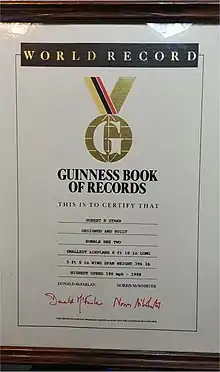Starr Bumble Bee II
The Starr Bumble Bee was an experimental aircraft designed and built specifically to acquire the title of “The World’s Smallest Airplane”.
| Bumble Bee II | |
|---|---|
.jpg.webp) | |
| Starr Bumble Bee II on display at Pima Air & Space Museum, Tucson, AZ | |
| Role | Record Breaker |
| Manufacturer | Homebuilt |
| Designer | Robert H. Starr |
| First flight | January 28, 1984 |
| Status | Museum Collection |
| Number built | 1 |
Design and development
The “Bumble Bee I” and “Bumble Bee II” were designed, built, and flown by Robert H. Starr of Phoenix, AZ. Both aircraft are an enclosed single-engine, negative staggered, cantilevered biplane style with conventional landing gears. The fuselage is constructed of welded steel tubing with sheet metal covering. The upper wings have flaps and the lower wings have ailerons. All wing airframe structures are equipped with tip plates to enhance the lift coefficient. The airplanes have a small cockpit with the rudder pedals located under the engine compartment toward the front of the cowling. The power plant is a Continental C85 4 – cylinder air-cooled horizontally opposed cylinder engine (Boxer Motor) that produces 85 hp.
Operational history
The Bumble Bee I was flown on several occasions from January 28, 1984 – 1986 to achieve the title of “World’s Smallest”. Mr. Starr then built the Bumble Bee II. It was both smaller and lighter. He flew the Bumble Bee II on May 8, 1988, at Marana Airport just outside of Tucson, Arizona, and acquired the title of World's Smallest once again. During one of the subsequent flights of the Bumble Bee II, the engine failed on downwind. The pilot Robert Starr sustained serious injuries as a result of the emergency landing. However, he recovered and the Bumble Bee II was donated to a private collection.
Aircraft on public display

The “Bumble Bee I” and the” Bumble Bee II” were designed and built specifically to acquire the title of “The World’s Smallest Piloted Airplane”. Pilot Robert Starr of Phoenix, Arizona, had been deeply involved with both previous titles holding “smallest airplane” projects. He was the co-builder and test pilot from 1953-1955 for both early record holder projects by the name of Sky Baby and JR. His partnership on these projects with Mr. Stits (co-builder) came to an end. Mr. Starr, however, had gained considerable experience and knowledge on these first airplanes during his building and test flying activities. He knew that a smaller, more aerodynamically superior plane could be built. Consequently, he decided to build [1] a smaller machine and establish a new world record on his own. The Bumble Bee I and Bumble Bee II were the result.[2]
Why did he name them bumble bee? Rumor has it that natures’ bumble bee does not have enough wing area to fly. At first glance, most engineers and professional pilots made the same statement about the Bumble Bee airplanes. Mr. Starr flew Bumble Bee II and captured the record in 1988 at age 64. See Guinness Book of Records for the official proclamation of the World's Smallest Piloted Airplane. The Bumble Bee I is on permanent display at the Pima Air & Space Museum in Tucson, Arizona.[3]
Specifications
General characteristics
- Crew: One
- Length: 8 ft 10 in (2.7 m)
- Wingspan: 5 ft 6 in (1.68 m)
- Height: 3 ft 11 in (1.2 m)
- Airfoil: 23012
- Empty weight: 396 lb (180 kg)
- Max takeoff weight: 574 lb (260 kg)
- Fuel capacity: 3 US gallons (11.35 litres)
- Powerplant: 1 × Continental C85 4-cylinder air-cooled horizontally opposed piston engine, 85 hp (63 kW)
Performance
- Maximum speed: 165 kn (190 mph, 305 km/h)
- Cruise speed: 130 kn (150 mph, 241 km/h)
- Stall speed: 75 kn (86 mph, 139 km/h)
- Service ceiling: 14,000 ft (4,270 m)
- Rate of climb: 4,500 ft/min (23 m/s)
References
- "Building the Bumblebee".
- "Flight of the Bumble Bee Airplane • Disciples of Flight". 2013-04-19. Retrieved 2019-10-04.
- "Starr Bumble Bee - Pima Air and Space Museum - Tucson, Arizona". Pima Air and Space Museum. Retrieved 2019-10-04.